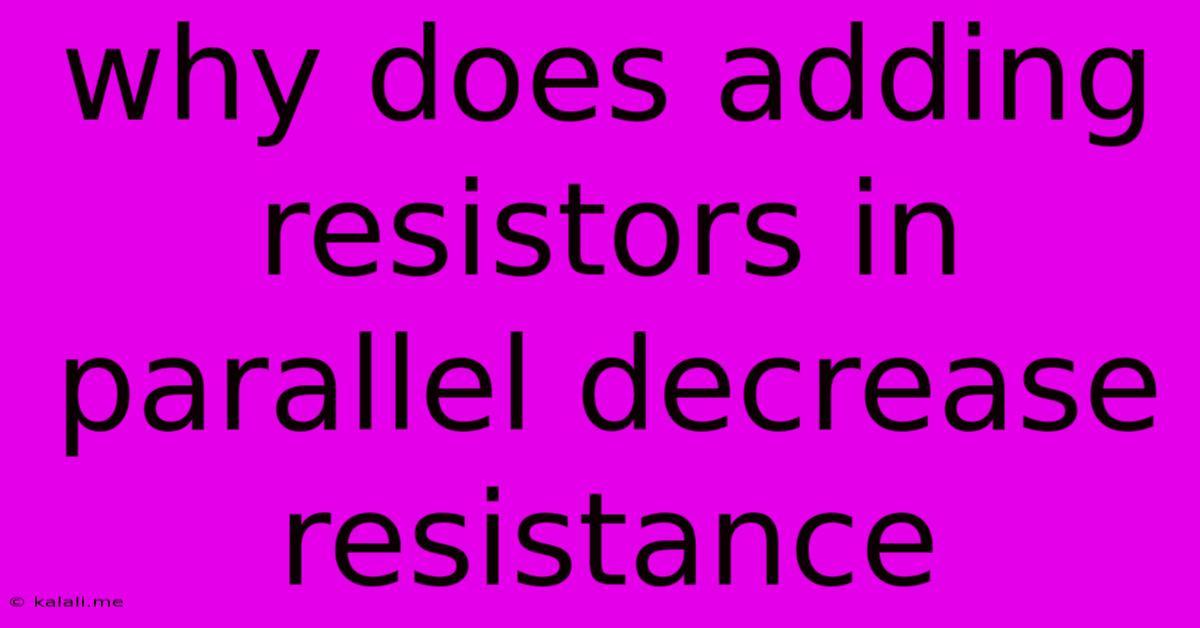Why Does Adding Resistors In Parallel Decrease Resistance
Kalali
May 21, 2025 · 3 min read

Table of Contents
Why Adding Resistors in Parallel Decreases Resistance: A Comprehensive Guide
Meta Description: Discover why connecting resistors in parallel reduces the overall circuit resistance. This guide explains the concept using simple analogies, calculations, and insightful illustrations. Learn how parallel circuits work and master this fundamental electrical principle.
Understanding why adding resistors in parallel decreases the total resistance is crucial for anyone studying electronics or working with circuits. This seemingly counterintuitive phenomenon stems from the fundamental nature of parallel circuits and how current flows. Let's explore this concept thoroughly.
The Analogy of Parallel Pipes
Imagine water flowing through pipes. A single, narrow pipe offers significant resistance to the water flow. Now, imagine adding another pipe parallel to the first. The water now has two paths to flow through, effectively doubling the capacity and reducing the overall resistance to flow. This is analogous to adding resistors in parallel; each resistor provides an additional path for current, reducing the total resistance.
The Physics Behind Parallel Resistance
The key lies in how current behaves in a parallel circuit. Unlike a series circuit where current flows through each resistor sequentially, in a parallel circuit, the current splits between the different branches. Each resistor experiences a portion of the total current. This division of current leads to a lower overall resistance.
Key Factors:
- Independent Voltage: In a parallel circuit, each resistor experiences the same voltage. This is unlike a series circuit where the voltage is divided across the resistors.
- Current Division: The total current is the sum of the currents flowing through each individual resistor. This is a direct consequence of Kirchhoff's Current Law.
- Reduced Impedance to Current Flow: The multiple paths available for current reduce the overall opposition to current flow, hence decreasing the total resistance.
Calculating Total Resistance in Parallel Circuits
The formula for calculating the total resistance (R<sub>T</sub>) of resistors connected in parallel is:
1/R<sub>T</sub> = 1/R<sub>1</sub> + 1/R<sub>2</sub> + 1/R<sub>3</sub> + ... + 1/R<sub>n</sub>
Where R<sub>1</sub>, R<sub>2</sub>, R<sub>3</sub>... R<sub>n</sub> represent the individual resistances. Notice that we find the reciprocal of the total resistance, then invert it to find the actual value.
Example:
If we have two resistors, R<sub>1</sub> = 10 ohms and R<sub>2</sub> = 20 ohms, connected in parallel, the total resistance would be:
1/R<sub>T</sub> = 1/10 + 1/20 = 3/20
R<sub>T</sub> = 20/3 ohms ≈ 6.67 ohms
As you can see, the total resistance (6.67 ohms) is less than either of the individual resistors.
Practical Applications of Parallel Resistors
Understanding parallel resistance is vital in numerous applications:
- Increasing Current Capacity: Parallel resistors are often used to increase the current-carrying capacity of a circuit without increasing the voltage.
- Creating Specific Resistance Values: By strategically connecting resistors in parallel, designers can achieve precise resistance values that aren't readily available as individual components.
- Load Sharing: In power supplies and other high-power applications, parallel resistors can distribute the load across multiple components, preventing any single component from overheating.
- Current Limiting: Parallel resistors, in combination with other components, can act as current limiters, protecting sensitive circuits.
Conclusion
The decrease in total resistance when resistors are connected in parallel is a fundamental principle of circuit analysis. By understanding the underlying physics and the associated calculations, you gain a more profound understanding of electrical circuits and their behavior. The analogies and examples provided should clarify this seemingly counterintuitive concept, equipping you with the knowledge to effectively design and analyze circuits involving parallel resistance.
Latest Posts
Latest Posts
-
What Time Is Dawn In Skyrim
May 21, 2025
-
How Long To Leave Grout Before Wiping
May 21, 2025
-
Thanks To The Both Of You
May 21, 2025
-
Two Prong To Three Prong Adapter
May 21, 2025
-
How Much Is A Half Million
May 21, 2025
Related Post
Thank you for visiting our website which covers about Why Does Adding Resistors In Parallel Decrease Resistance . We hope the information provided has been useful to you. Feel free to contact us if you have any questions or need further assistance. See you next time and don't miss to bookmark.